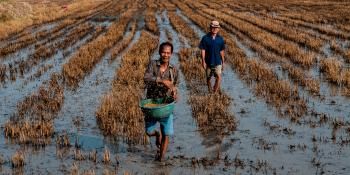Nationally appropriate mitigation actions increasing; Peru launches plan in December

Nationally Appropriate Mitigation Actions enable developing countries to transform their economies to meet the needs of a sustainable future by supporting sustainable practices, policies and projects in a range of sectors, including low-emissions agriculture.
Peru announced a Nationally Appropriate Mitigation Action (NAMA) in December. Called iNAMAzonia, Peru will sustainably intensify coffee, cocoa, livestock, and oil palm and restore degraded forest in the Amazon.
Minister of Agriculture Juan Manuel Benites Ramos said the country will implement NAMAs as important tools for increasing agricultural production without decreasing forest cover. He said:
We embark on this change process by introducing crops are all needed in world markets, as well as livestock to reduce carbon emissions within the framework of sustainable agriculture for smallholders. We want to increase productivity through the use of certified seed, appropriate tree species, agroforestry practices and sustainable utilization of water sources.”
Read the full story on Peru's new agricultural NAMA by the World Aroforestry Centre.
The Annual Status Report from ECN and ECOFYS also highlights increasing NAMA activity, and the currently unmet potential for transformational change in the agriculture sector. Only 3% of NAMAs were in the agriculture sector, indicating significant unmet potential.
The pre-2020 NAMAs should be seen as demonstration projects that, if successful, will set the economic processes of transformation in motion... It is likely that the Intended Nationally Determined Contributions, due to be submitted in early 2015, will fully or partly consist of NAMAs to be implemented after 2020.” (Tilburg et al. 2014)
But will NAMAs bring transformational change, and how will they fit into a post-2020 climate regime? These questions hang in the air as discussions build towards the 2015 Climate Agreement in Paris.
Despite the rising rate of NAMA submissions, challenges remain in funding and implementing NAMA plans. The enthusiasm of countries and practitioners for NAMAs has not been met by development finance institutions (DFIs) which have been slow to commit funding for NAMAs.
The Green Climate Fund can potentially be a strong supporter of NAMAs that meet its investment criteria. Even so, funding from the private sector will be necessary. To attract private sector investment, NAMAs must be economically viable, and creating conditions that will promote equitable private investment in NAMAs is difficult. In order for funds to be channeled efficiently, cooperation between national governments, funders and the organizations that help countries create the infrastructure to implement NAMAs is critical.
In the long term plan of NAMA implementation, monitoring also poses significant challenges. As with defining NAMAs, the balance between too much structure and too little structure in monitoring systems is a delicate one.
Measurement, reporting and verification systems that are too cumbersome will deter countries from implementing NAMAs, but insufficient systems could encourage corruption and make it difficult to improve mitigation projects. In agriculture, there is an urgent need for clear and flexible guidelines and methods for measuring and verifying emissions reductions. Read more about recent innovations in low-cost methods for emissions estimation and the CCAFS SAMPLES program.
The NAMA Registry may be able to play a key role in sharing information and streamlining allocation of funding, but thus far, it has failed to fulfill its proclaimed function of matching NAMAs with funding and providing a platform for sharing information. Another potential resource for NAMAs is the Joint Crediting Mechanism which seeks to create low carbon societies. The mecanism can support NAMAs to enable effective decision making among stakeholders and expand networks and partnerships.
In short, there are many organizations and institutions that are working towards successful implementation of NAMAs, and the growing number of ambitious NAMAs submitted to the NAMA Registry is a clear indicator of rising need and willingness to work with the NAMA framework in developing countries.
Though further efforts to streamline NAMAs and establish institutional systems for channeling funds are needed, NAMAs are on track to be successfully implemented if sufficient funding is produced. Seeking stable funding is critical for preparing for the 2015 Climate Agreement in Paris and a sustainable future.
Susan Onyango is a communications specialist with the World Agroforestry Center. Sonya Buglion-Gluck is a student at the University of Vermont's Rubenstein School for the Environment and Natural Resources.


